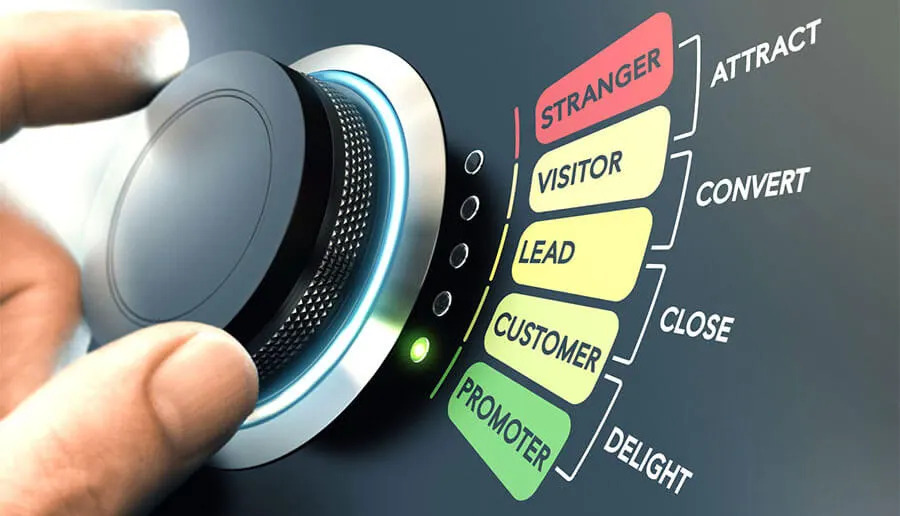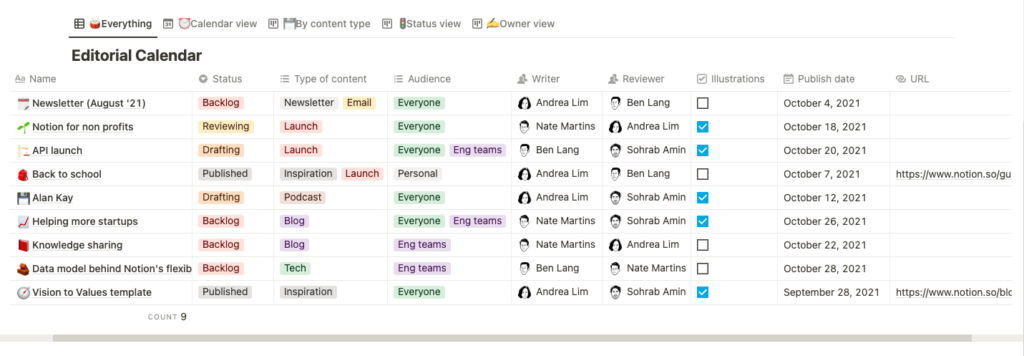What is Inbound Marketing?
Inbound marketing is a methodology applied to attract potential customers to your brand using SEO, content marketing, social media etc. through all effective channels that put you in front of your target audience and lay the groundwork for engaging with them.
The most effective way to engage your audience is to create high-quality and useful content that educates, inspires and brings them closer to your brand.
While inbound marketing mainly aims at converting a lead into an advocate of a brand; when it comes to international trade, its first goal is to attract the potential buyers and get them to contact you in person using various types of CTAs (Call to Action).
Most of the businesses don’t have a standard pricing policy and prices change according to the prospect’s country, order quantity, modification (product, labelling, packaging) demands, payment terms etc.
So, it’s not always possible to set a fixed price to the product or service and to make the leads check out with a few clicks.
However, although it’s regarded as a thing of domestic marketing or international SAAS companies, inbound marketing serves the same purpose for exporters with minor differences.

How Is Outbound Marketing Different From Inbound Marketing?
In international trade, traditional marketing channels have always been popular and are considered to be the best way to promote the products or services.
These traditional marketing activities are all about reaching the potential buyer without their consent, and naturally they are not only expensive but also unlikeable by the prospect’s side.
Because they never showed their interest in your offering, you just showed up and expect them to take their time for a pitch.
What would you do if you were in their shoes?
This type of marketing approach we call outbound marketing.
Among the mostly used tactics that define outbound marketing are trade shows, exhibitions, cold calling, cold emailing, sample and promotional products shipping.
As you see, these are quite costly and time-consuming activities that require big effort, and the ROI is much lower than inbound marketing.
You must be guessing how much to spend on international calls, ads, visits, trade shows; especially if you haven’t determined your target markets and are trying to reach out to all the companies from around the globe.
Instead, spending that much money on SEO and content marketing will bring you the prospects who are more likely to be ready to buy from you.
Is outbound marketing entirely useless? Of course not. A wisely developed marketing strategy is a combination of all available channels that align with the goals and capabilities of your company.
The point is that, neither be limited with the old habits of outbound marketing nor exploit all the inbound channels without considering if they are convenient for your niche or not.
Just track your audience; be visible and ready where they are.

How Does Inbound Marketing Make The Difference?
What differentiates inbound marketing from outbound is that inbound marketing has a trust advantage over outbound. Because the prospect is the one who needs your product/service and starts with search engines.
Then it visits the website and social media accounts of the companies listed in the first 2-3 pages of search engines. If you are one of them, that is the moment when the prospect has an impression on your brand and decides to try you or not.
If it’s positive, that action is taken only thanks to your inbound marketing activities and you become a thought leader in the eyes of them. Furthermore, that kind of audience is proven to be the right audience in that they find you and show their interest.
On the other side, in outbound marketing, you reach out to people who you think are your target audience. Actually they are not your audience, they are just the companies targeted by you in your STP analysis.
The Stages of Inbound Marketing
An effective inbound marketing strategy is divided into 4 main stages: attract strangers to your brand, convert them into leads, close the deal and delight your customers.
Normally these stages are designed for online retail purchases or subscriptions, but it can be easily adjusted to the B2B sales process.
As in B2C, attract strangers to your brand, convert them into leads, hand them over to the sales team to close the deal and delight your customers with personalized support.

Attract
The first stage of inbound marketing starts with attracting the target audience to your brand. To do this, you have to identify what direct and indirect channels they are using to learn about your industry.
Then you have to increase your online presence and make sure your brand promotion activities perform well.
The most effective channels all around the world are your website and social media platforms.
Being active in those channels is not enough alone. It needs a well conceived content marketing and SEO strategy so they can rank high in Google search and be visible in your audience’s social media feed.
Convert
Ok, you got your audience’s eye. They visit your website and check your social media accounts. Now what? What would you do if you were them?
First of all, I would want to be sure whether you are the right company for me.

Then, I would either save your website for later and maybe follow your social media accounts, or I’d look for a button or something to ask for more personalized information.
Think about these 2 steps. How would you restructure your website to prompt the visitors to take action?
The answer is simple: a fast, well designed and secure website with high-quality blog posts, high-quality photos, videos, footage and a bunch of information about what you are doing. This is how you pass the “gain trust” phase.
Next is the part where you urge them to get into action. Use every means possible to get connected with them:
- Sign-up forms
- Sample request forms
- Price request forms
- Inquiry forms
- Calls-to-Action (CTAs)
Close
At this stage the sales team takes over the job as marketing activities continue to keep the leads with you. Because they are qualified as marketing leads but closing hasn’t happened yet.
Differently from B2C, in B2B closing a deal takes time with negotiations, quotations, correspondence, haggles, sample checks and so on.
Delight
Congratulations! You closed, but it’s not over.
If you want to make your customer satisfied with doing business with you, retain the partnership and to keep the relationship warm, you should always be on their minds and screens.
To show that you value your customers, receive feedback, provide technical and intellectual support; keep them informed and updated with brief sheets, personalized emails, valuable hints & tips and insightful analysis about the industry.
Who would say no to all these?

Mixing Account Based Marketing and Inbound Marketing
As a result of all your inbound marketing efforts, you happened to create an ever-growing best-fit audience list to market to.
At the close stage, some of them turned into customers while a big percentage of the list stayed as non-customers.
What we need to do in the next step is design another strategy which will apply to both groups: combining ABM and IBM strategies.
ABM is a personalized marketing strategy focused only on targeted accounts carried out with the collaboration of marketing and sales teams.
In this new system, while the existing inbound marketing strategy is running for non-customers, ABM takes over the high-value leads at the close stage. Because that’s where a lead shows its interest and according to the level of interest it has a potential to turn into a high-value account.
At this point, ABM applications come into play such as personalized e-mails, proposals, newsletters, whatever they are that are planned only for that specific customer. Afterwards, the ABM team works on building strong relationships with key accounts.
How to Implement an Inbound Marketing Strategy
Understand your audience
To start with, get to know your audience:
- Define your ideal customers (producers, wholesalers, direct importers, distributors, end users)
- Define their pain points. Try to find out what they are searching on Google using the keyword finder tools like Google trends. Ask also your existing customers about what problems they have in the industry. Their feedback will help you with your content strategy a lot.
- Depending on the country, their use of digital platforms varies. Track where your audience is and concentrate on those channels in your content strategy.
Determine Your Channels
Your website will be your online home where you first welcome strangers and lead the way to your offering. So, if you still don’t have one, have an SEO optimized perfect website right away.
Open social media accounts relevant to your industry and give a professional outlook. The look is as important as content; use consistent brand colors, fonts, and templates.
Plan Your Content Marketing

Content marketing is by far the most crucial part of our inbound marketing efforts. Implementing an effective content marketing strategy will make your goals, vision and value proposal crystal clear and make your brand known to your audience when done properly and systematically.
All your interaction and engagement with your audience is only possible with a successful content marketing strategy. Otherwise you’ll be a grain of sand in the desert.
In your content marketing efforts, always remember that you are creating content to attract strangers and convert them to leads; then to delight.
So, your content should be authentic, credible and high-quality in terms of being informative, helpful, useful, entertaining, inspirational and engaging.
They should also be answer to their questions and solutions to their problems.
To incorporate an effective content marketing strategy into your overall inbound marketing strategy, go with these 7 main steps:
#1 Goals
At the outset of content strategy, define your goals. What do you want to create content for? What results are you aiming to achieve?
Are you aiming to get more traffic to your website? Increase your social media account engagement? To be seen as a thought leader?
Whatever goals you pursue, make sure they are as specific as possible. That’s the only way you can establish measurable, achievable and relevant KPIs.
#2 KPIs
KPIs (Key Performance Indicators) are used to measure your performance for a set of specific objectives and targets.
For example, you set a specific objective to achieve like increasing your website traffic, social media engagement, conversion rates, followers or subscribers. But it doesn’t define, by itself, a key performance indicator.
In order to call an objective KPI it should be SMART (Specific, Measurable, Achievable, Relevant, Time-bound) like “Increasing monthly visitors to your website up to 10.000 in 6 months.” The key point here is to define achievable numbers. I know you want quick and great results, but Rome wasn’t built in a day; be patient and reasonable.
When you set such a smart objective, you can develop your plan more easily, because you know exactly what the challenge is and what needs to be done to succeed.
#3 Keywords
When it comes to content marketing strategy, keywords are a critical element of your success.
Without knowing which keywords are the most popular in your industry, you would be the one that reads what you write, listens to what you record, likes what you post, watches what you produce; zero conversion.
If you don’t have an active blog page and social media accounts, you can start with analyzing your competitors’ activities.
There are various useful tools to help you find the best performing keywords and make competitor analysis and content audit. The most commonly know ones are:
- Google Trends
- Google Keyword Planner
- SEMrush
- SimilarWeb
- Ahrefs
- Spyfu
- MozzBar
- BuzzSumo
#4 Content Channels

Just because there are a ton of social media channels, you don’t have to use all of them; actually you shouldn’t. That will ruin your focus and cause a loss of time and money.
To perform well and get great results that convert, you should focus on the ones that align with your brand identity. To do that, you have to know what platforms your audience is using and from which channels they are coming from.
You can use Google Analytics or BuzzSumo to get this information.
#5 Content Types
After you determine your channels, now it’s time to decide on what kind of content you’ll create to attract your audience.
The most effective content types:
- Blog Posts
- Infographics
- Landing Pages
- Podcasts
- Social Media Posts
- Video
- Website Homepage
- Ebooks
- Webinars
- Emails
- Newsletters
- White papers
#6 Content Calendar
Keeping your content marketing efforts organized will absolutely save you time and prevent the mess.
Knowing what to publish beforehand, also prevents you from panicking when the day comes; because you have already planned your editorial calendar and prepared the content.
You can create simple editorial with Google calendar, Google spreadsheets, Notion etc.
This is an example of an editorial calendar from Notion templates you can use for free.

#7 Create Content
Having completed all these steps, you have valuable information about what kind of content you’ll create, the channels, topics and a roadmap.
Now is time to create your engaging and compelling content and measure the KPIs. That said, as you continually measure the impact and results of your campaigns, do not hesitate to make adjustments and revisions to the tactics in your overall strategy if you don’t get the desired results.
Remember, this is a living project and it’s okay to make small changes unless it’s too big to change the strategy itself. Strategy pays off in the long run, so if you’re not happy with short-term results, it’s not because your strategy is wrong, it’s because it takes time to reap the fruits of your hard work.
Convert

Finally, it’s time your hard work pays off. All your marketing efforts are for one thing: turn the leads into customers.
You have reached the goals in your KPIs and getting hits on your contact buttons (or whatever you aimed) and the sales team is busy with closing the sales.
And what’s next? You know what’s next: delight your customers, give ABM great importance, attract new leads; keep your brand voice super active, your marketing activities sharp and updated with new goals to span the boundaries; just keep growing.













